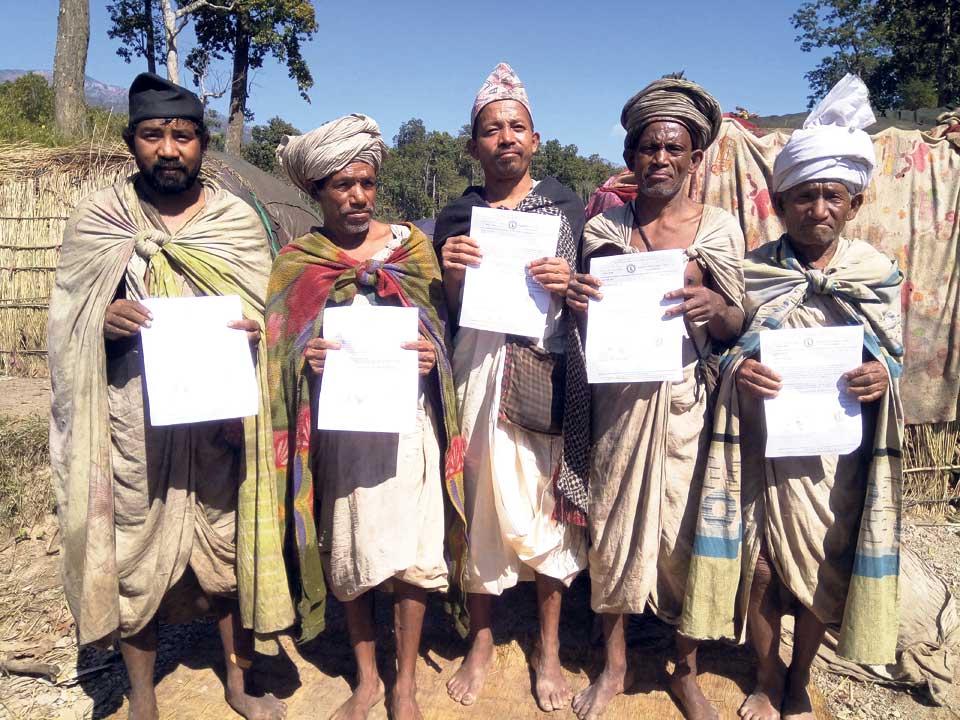The Raaute people are indigenous to Nepal and belong to the endangered nomadic indigenous communities of South Asia. The Raaute reside primarily in the districts of Dailekh, Surkhet, Dang, Salyan, Achham, Kalikot, Jajarkot, among others, in the Lumbini, Karnali, and Sudurpashchim provinces of Nepal. They speak their own Tibeto-Burman language, known as Raaute, and are known to communicate effectively in Nepali as well. Despite practicing the Tibeto-Burman language, they are said to have Mongolian roots according to some sources. However, those who reside in the Karnali Province consider themselves Khas Thakuris. According to their own accounts, the Raaute people are considered Khas Thakuris.
Especially during the reign of Prithvi Narayan Shah and the establishment of the Western state, it is speculated that they lived in the jungles, possibly evading the contemporary Gorkha Shah rule. This community is known for residing in jungles, hunting monkeys, and surviving by consuming wild fruits, flowers, and other forest products. Their culture is unique to their community, and they continue to preserve traditions such as Lathiloro, Majira, Madal, and Dhyangro music even as they move from one place to another.
According to the 2078 B.S. census, there are currently a total of 46 households in this community, with a total population of 143 Raaute individuals. Previously, the Raaute people were reluctant to participate in population censuses. However, after the government started providing sustenance allowances, the Raaute people have been more willing to be enumerated.
Some Raaute individuals have abandoned their nomadic jungle lifestyle and have settled in Dadeldhura. Others, however, still prefer to live their lives wandering in the jungle.
The Raaute people lead a nomadic lifestyle, preserving their self-reliance. They fashion various tools from jungle wood and take these to villages, trading them for food and other necessities. Their daily routine involves crafting wooden materials, hunting monkeys, and traveling to nearby villages for barter and sustenance.
The Raaute people, consider themselves criminals if they settle in one place and cultivate land or consume food in someone else’s houseThey possess only a few tools, such as knives for cutting and hunting, as wealth. Their culture revolves around preserving and using what they can carry.
The Raaute people who lead a nomadic life don’t settle in one place for long. If a member dies in a location where they have been for some time, it becomes imperative for them to leave immediately. The ritual of crying and mourning takes place, and they search for another location to set up camp, following the belief that staying where someone has died brings bad luck.
Traditionally Raaute men wear a topi (hat), pheta (scarf), langoti (loincloth), and carry a khukuri, while women wear a choli (blouse), fariya (skirt), and adorn themselves withjewelleres made for iron and brass.
They have a unique tradition of worshipping their own gods Masto and Bhuyar. Hinduism has influenced their religious practices, and they also celebrate Maghe and Dashain festivals.
The chief man among the Raute is called the “Mukhiya.” They operate under the guidance of the Mukhiya, who leads them. In the past, there used to be only one Mukhiya, but now, there are three Mukhiyas, each from different subgroups: Kalyal, Raskoti, and Sovanshi. Additionally, there is one overall chief Mukhiya. The former chief Mukhiya, Ain Bahadur Shahi, passed away as he fell from a cliff. Currently, based on the caste system, Surya Narayan Shahi, Veer Bahadur Shahi, and Dil Bahadur Shahi serve as Mukhiyas.
There is a shortage of Raaute women in the community. While the population of Raaute individuals from the Kalyal lineage is higher, the Sovanshi and Raskoti lineages have fewer members. In terms of marriage, Raaute youth from the Kalyal lineage face difficulty finding Raaute brides.
Some marry at a young age, while others, even after reaching maturity, struggle to find suitable matches. Interestingly, a single woman from the Kalyal lineage is considered a bad omen and is unable to observe the mourning rituals after someone’s death.
Raaute in a Declining Population Scenario With only 143 individuals as of the latest count, the Raaute community is in a declining population situation. Environmental changes and the rapid social transformation have contributed to a significant decrease in the Raaute population. It is possible that if the Raaute do not adapt to the changing times and continue their nomadic lifestyle, they may soon become a thing of the past.



